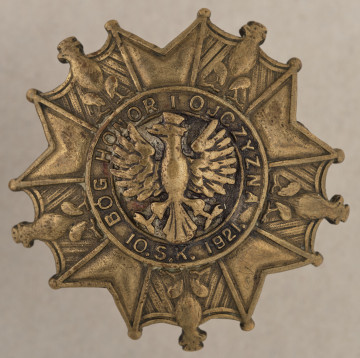
Gas mask
20th century
Castle Museum in Łańcut
Part of the collection: History of the city and the region
Chauffeur's glasses were a common piece of field equipment for mobile forces. They had been used in the 10th Mounted Rifle Regiment since 1937, when the unit was motorised. They were commonly referred to as goggles or “Zetes” – from the name of the manufacturer, Wytwórnia Okularów Ochronnych "Zetes" in Warsaw. They were given out to troops riding various vehicles, and their function was to protect their eyes from dust, which was the bane of soldiers driving in car columns on mostly dirt roads. The glasses were carried in a metal box embossed with the ZETES name. Officers and NCOs purchased them on their own, so these may have differed slightly from standard issue goggles. According to an order issued on 7 November 1938 by the commander of the 10th Cavalry Brigade, chauffeur glasses were to be worn at the neck on the collar of the coat when making official appearances. In turn, on 19 March 1939, in the parade, according to the order of the Brigade Commander, the brigade was supposed to parade in leather coats, helmets and glasses on collars. Polish chauffeur's glasses were modelled on the French aviation glasses used by the Polish Air Force back in the 1920s. Their shape was particularly fashionable, especially for aviation and automotive goggles used at the time in Europe. The wide cushions of white rubber on the aviation variant were replaced by narrow cushions of brown or black rubber. The frames of the goggles were made of aluminium and had vent holes all around. The adjustable strap to secure the goggles around the head was made of rubber. The glasses were transparent and non-tinted, unbreakable and non-flammable. A plate with "Zetes" engraved on it was installed between the lenses. Chauffeur's glasses, according to the regulations, were worn around the neck so that the strap of the glasses was on the collar. Officers of mobile units, who were forced to leave their vehicles and fight on foot, were supposed to leave their glasses on their vehicles. It was forbidden to wear glasses on a beret or helmet because of possible damage. The ban on wearing glasses on the helmet did not apply to tank helmets, chauffeur caps, and leather hoods, whcih had special hooks for the strap. Joanna Kluz
Author / creator
Dimensions
height: 5 cm, width: 2.5 cm
Object type
History of the city and the region
Technique
installation
Material
metal, leather, plastic, rubber
Creation time / dating
Creation / finding place
Owner
Castle Museum in Łańcut
Identification number
Location / status

20th century
Castle Museum in Łańcut

1925 — 1928
Castle Museum in Łańcut

1796
National Museum in Szczecin
DISCOVER this TOPIC
National Museum in Szczecin
DISCOVER this PATH
Educational path